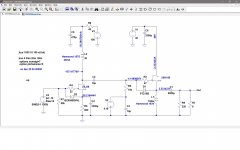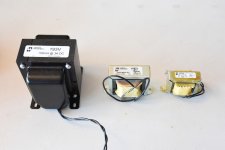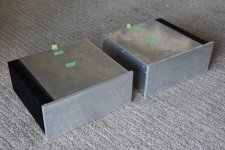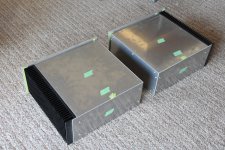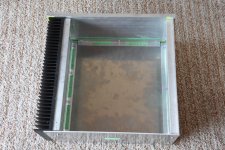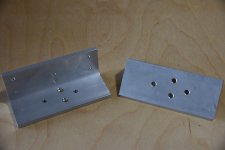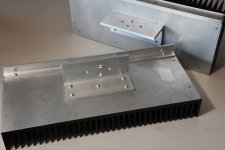Earlier this year, I built a 2SJ82 source follower amplifier with 2SK82 gain stages. This is an amplifier which I really enjoy, so I decided to build a pair of source follower monoblocks using 2SK180 SITs. For a little change-up, I will use a choke loaded 2SJ28 gain stage instead, and the 2SK180 will be choke loaded as well. The power supplies will be CLC so there will another choke in the mix. So mo' chokes and mo' power. I was thinking of calling this amp Henry or Henrietta, depending on what gender it turns out to be.
I finally completed fabricating the two cases for the monoblocks today, and that for me, is a major milestone. There is still more work to be done on them but it always feels good when all the pieces fit and holes don't need to be enlarged to force things together. I still need to fabricate the mounting angles for the SITs, drill the back panel, and drill holes to mount the electronics but that will only take a couple of days. Then I will start building the electronics.
The interior of the cases are 13.75 inches by 13 inches so I'll have lots of room to arrange things. The heatsinks are Conrad MF35-151.5 (0.21 C/W for 80C rise).
Another name possibility just came to me: Mo-Cho
I finally completed fabricating the two cases for the monoblocks today, and that for me, is a major milestone. There is still more work to be done on them but it always feels good when all the pieces fit and holes don't need to be enlarged to force things together. I still need to fabricate the mounting angles for the SITs, drill the back panel, and drill holes to mount the electronics but that will only take a couple of days. Then I will start building the electronics.
The interior of the cases are 13.75 inches by 13 inches so I'll have lots of room to arrange things. The heatsinks are Conrad MF35-151.5 (0.21 C/W for 80C rise).
Another name possibility just came to me: Mo-Cho
Attachments
Last edited:
If you need about - 4.148 - bias voltage and you are already developing - 2.33v across the inductor's 1 ohm resistance simply adding a .85 ohm resistor in series with the resistor would give you your required -4.148 v of bias without needing a separate - bias source. Oh you might need to play with that resistor value a little.
I fabricated the 2SK180 mounting angles today and test fitted them to the heatsinks. The angles are 2 x 2 x 0.25 inches x 5 inches long. Happily, everything fit without any issues. Blind taps into heatsinks are not my favourite things. Since spring has come to the Great White North, I even changed out my snow tires. A productive day.
Attachments
I fabricated the 2SK180 mounting angles today and test fitted them to the heatsinks. The angles are 2 x 2 x 0.25 inches x 5 inches long. Happily, everything fit without any issues. Blind taps into heatsinks are not my favourite things. Since spring has come to the Great White North, I even changed out my snow tires. A productive day.
That's funny. That's the same aluminum angle I use. Easy to get and work with.
Regards,
Dan
I fabricated the 2SK180 mounting angles today and test fitted them to the heatsinks. The angles are 2 x 2 x 0.25 inches x 5 inches long. Happily, everything fit without any issues. Blind taps into heatsinks are not my favourite things. Since spring has come to the Great White North, I even changed out my snow tires. A productive day.
That's funny. That's the same aluminum angle I use. Easy to get and work with.
Regards,
Dan
I like the idea, but will that heatsink be enough? 88W is a lot of heat. Or do you plan to put a fan on the heatsinks?
This is a choke fed follower amp design I built some years ago, but I didn't choke load the voltage gain stage. I also used Sziklai arrangements in both stages (and MOSFET instead of power JFET devices).
2nd Spring -- another stab at the SE choke-fed Class A Power Amp

This is a choke fed follower amp design I built some years ago, but I didn't choke load the voltage gain stage. I also used Sziklai arrangements in both stages (and MOSFET instead of power JFET devices).
2nd Spring -- another stab at the SE choke-fed Class A Power Amp

My 2SK82 - 2SJ28 amp dissipates about 68 watts between the IRFP250N CCS and the VFET with the same Conrad heatsinks. The case temperatures are at about 53C while the heatsinks measured at the base on the outside are at about 42C. So, I will monitor temperatures of the 2SK180 when I get it running and decide how hot to bias it and what I am comfortable with. The case plates are all 1/8 inch with 3/8 inch front plate and they will help dissipate some heat as well.
I bought a plug tap to add to my taper and bottoming tap collection and decided to try tapping the holes blind. Using the taper tap, plug tap, and then the bottoming tap in that order works like a charm. Actually, I was more nervous tapping the 3/8" from panel.
I bought a plug tap to add to my taper and bottoming tap collection and decided to try tapping the holes blind. Using the taper tap, plug tap, and then the bottoming tap in that order works like a charm. Actually, I was more nervous tapping the 3/8" from panel.
Hi pinholer, very beautiful, you could replace the two SITs with the triodes and nothing would change. Except for the filament power supply.
I have two questions:
1 How do you get the Vgs present when the rail regulator power up o power down?
2 How do you reduce the noise from the power supply to a minimum? The Drain impedence of SITs could be a problem.
Claudio
I have two questions:
1 How do you get the Vgs present when the rail regulator power up o power down?
2 How do you reduce the noise from the power supply to a minimum? The Drain impedence of SITs could be a problem.
Claudio
I will be building an independent power supply complete with its own transformer and regulation. Its RC timing will be quicker that of the SIT's power supply so it will appear at the gate before the power to the drain. A electrolytic capacitor on the bias supply output will keep the bias voltage up on shutdown. Also, the choke load on the source has a DC resistance of about 1 ohm so it will provide some self bias.
My main power supply will be CLC with 50 mF capacitors and 10 mH choke (Hammond 159ZJ). PSUD2 modelling shows less than 1 mVp-p ripple. I have the same power supply on my 2SK82 - 2SJ28 amp and it is very quiet. I use it to power JBL 2445 and 2405 compression drivers and I cannot hear any noise from them. You can see some test results at 2SK82 -2SJ28 SE Amp.
My main power supply will be CLC with 50 mF capacitors and 10 mH choke (Hammond 159ZJ). PSUD2 modelling shows less than 1 mVp-p ripple. I have the same power supply on my 2SK82 - 2SJ28 amp and it is very quiet. I use it to power JBL 2445 and 2405 compression drivers and I cannot hear any noise from them. You can see some test results at 2SK82 -2SJ28 SE Amp.
Last edited:
@claudio52, before I discovered SITs through this Pass forum, I was an all out tube guy, so it is probably not a coincidence that this design is similar to a tube design. I got hooked on tubes through the Joelist way back before the WWW and subscribed to Glass Audio magazine and Doc Bottlehead's newsletter. I was big into single-ended DHTs; now everything is SIT except for my phono preamp. Still into high efficiency speakers, though.
Spice confirms the decrease in distortion. In my Luminaria I chose with Arta the operating point with the lowest distortion, but also with the best residual of pure second harmonic (negative). This is not the lowest point of THD. I have not made comparisons with other operating points. I trust Nelson Pass.
- Home
- Amplifiers
- Pass Labs
- Mo' Chokes: Building 2SJ28 - 2SK180 Monoblocks
